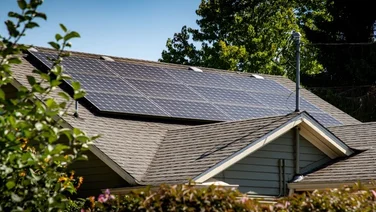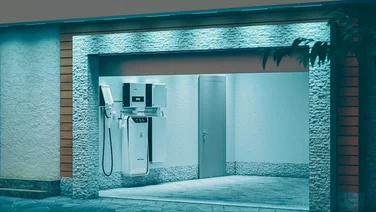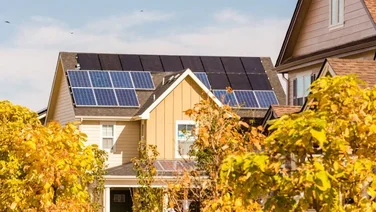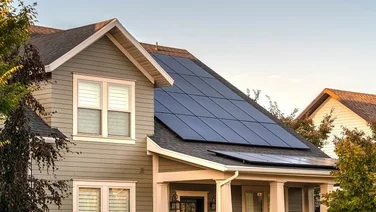Solar panels have exploded in popularity over the past decade – with global capacity growing by 19% in 2021 alone (International Renewable Energy Agency, 2022).
And with countries around the world driving toward their net-zero goals, we can expect this trend to continue in the coming years.
Despite this dramatic growth, many people are still very new to the concept of solar energy, and how panels can transform sunshine into electricity.
Sound familiar? Don’t worry, we’ll guide you through everything you need to know about how solar panels work in this article.

What’s on this page?
How does a solar panel work?
Solar panels work by absorbing sunlight and turning it into energy, which can then be used to power appliances and buildings.
To get a better idea of the process, check out the step-by-step guide below:
- Panels absorb sunlight – This can happen on both sunny and overcast days
- Solar cells generate electricity – When photons in sunlight hit a solar cell, they shake the electrons in the phosphorus layer loose, and they travel to the layer containing boron. When sunlight reaches the panel, creating direct current (DC) energy
- DC electricity is then converted into AC electricity – DC electricity can’t be used to power homes, so it’s converted into alternating current (AC) electricity by an inverter (a small gadget located behind the panels)
- The energy powers the property – Once the solar energy has been converted from DC to AC electricity, it runs through the property’s electrical panel, and is distributed throughout the building to power appliances
What is solar panel efficiency?
Solar panel efficiency measures a panel’s ability to convert sunlight into electricity. So, if the sun shines on a solar panel that has a 20% efficiency rating, 20% of the sun’s energy will be converted into electricity.
Most of today’s commercial solar panels have an efficiency rating of between 15% and 20% – though some solar panels can now reach 22% efficiency.
This number is also expected to carry on growing in the coming years, as experts continue to find ways to improve solar panel efficiency.
We only need to look at recent studies to see just how much solar panel efficiency is improving. In early 2022, a team of researchers at the US Department of Energy’s National Renewable Energy Laboratory (NREL) created a solar cell with a record efficiency of 39.5%.
Although domestic solar panels aren’t quite at that level yet, it shows a promising sign for the future.

What are the best conditions for a solar panel?
Being in optimal weather conditions
It’s a common misconception that solar panels work efficiently in hot weather. Solar panels are generally tested at about 77°F, which means they perform at peak efficiency between 59°F and 95°F.
The panels will start to lose efficiency by about 0.35% for every degree the temperature goes above 95°F.
On the flip side of this, solar panels can also generate electricity on dull overcast days – they just won’t be able to produce as much energy as they do on mild sunny days. On average, light cloud cover will lead to a power output loss of 23.8%, while heavy cloud cover will reduce the output by 66.8%, according to the latest scientific research.
Facing southwards
To make sure your solar panels are getting as much sunshine exposure as possible, you’ll want to make sure they’re facing southwards. This rule changes from country to country – it all depends on which hemisphere they’re located in.
So whilst US solar panels need to face south, panels in Australia need to face north.
Angled in the optimal position
Generally, solar panels in the US need to be tilted vertically at an angle between 30° and 45°. However, since America covers a large surface area, the specific angle will differ depending on your exact location.
Angling solar panels in this way exposes them to more sunlight, which will:
- Make the panels more effective
- Lead to more savings on energy bills
- Act as a self-cleaning method, as the rain will wash off any debris
Avoiding the shade
Angling your solar panels between 30° and 45°, facing them southwards, and being in the perfect location with lots of sunshine hours will all be pointless if your panels are sitting in the shade.
When installing solar panels, make sure to clear away anything that might cast a shadow on your panels – particularly any big trees – which can reduce the solar output.
Keeping them clean
Similar to the point above, it’s pointless working hard on the optimal angle and direction of the panel if the sunlight gets blocked by dirt or debris resting on the surface of the panel.
It’s therefore best to keep your solar panels clean, wiping them down at least twice a year. You can either do this yourself or pay around £100 for a professional to do it for you.
Where are solar panels the most popular in the US?
Naturally, most sunny spots in the US are perfect for solar panels, but Honolulu tops the charts. A recent study suggests that the city has the most solar capacity per capita in America, followed by Las Vegas and San Diago.
The 2022 Shining Cities Survey, conducted by the Environment California’s Research & Policy Center, found that Honolulu has 1,133.5 watts of solar capacity per person. See how this compares to the other front runners in the chart below.
| City | State | Solar capacity per capita (watts per person) | Total solar capacity |
|---|---|---|---|
Honolulu | Hawaii | 1,133.5 | 397.8 |
Las Vegas | Nevada | 689.9 | 442.8 |
San Diego | California | 337.4 | 468.0 |
What’s the future of solar panels in the US?
Solar power in the US is set to increase a lot during the next few years – and this is a trend we’re already beginning to see.
The US installed 4.6 gigawatts (GW) of solar PV capacity in Q2 2022, helping the country reach 130.9 GW of total installed capacity, according to the Solar Energy Industries Association. That’s enough to power 23 million US homes.
On top of this, solar accounted for 39% of all new electricity-generating capacity in the US during the first half of 2021.
Residential solar is also breaking records, after it had its largest quarter in history in 2022, installing 1.36 GW – its fifth quarterly record in a row.
But if America – and the rest of the world – wants to continue this momentum, the solar industry needs to push for even more innovation. Thankfully, that’s already happening.
Some of the most recent developments on the solar panel scene include:
- Perovskite solar panels – These are tandem solar cells (two solar cells stacked one on top of the other), which are created when a thin perovskite cell is placed on top of a standard silicon cell. In 2018, Oxford PV demonstrated that its perovskite-silicon tandem cells could work at 28% efficiency – around one-third more than current standard PV panels
- Quantum dot solar panels – These solar panels could seriously increase solar efficiency. Light is made of particles called photons, and solar PV technology converts photons into energy. But quantum dots have something called a “multiple exciton generation” effect, which squeezes out more energy from each photon. Some studies have found that quantum dot solar cells could even reach a 66% conversion efficiency rate
- Zombie solar panels – These cells are based on a surprising discovery, which found that some solar cells actually work better when the liquid electrolyte built into them dries out – hence the name “zombie solar cells”. They even have power conversion efficiencies of 30%–34%, despite being the size of a credit card or mobile phone
Summary
Hopefully you’re feeling a little more confident about the solar panel basics after reading this article. Despite doing something pretty incredible – turning sunlight into actual usable energy – solar panels are pretty straightforward pieces of kit.




